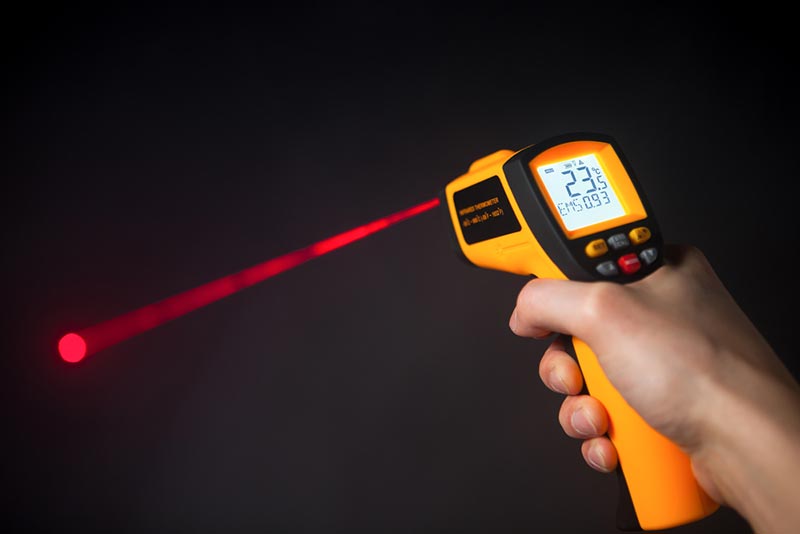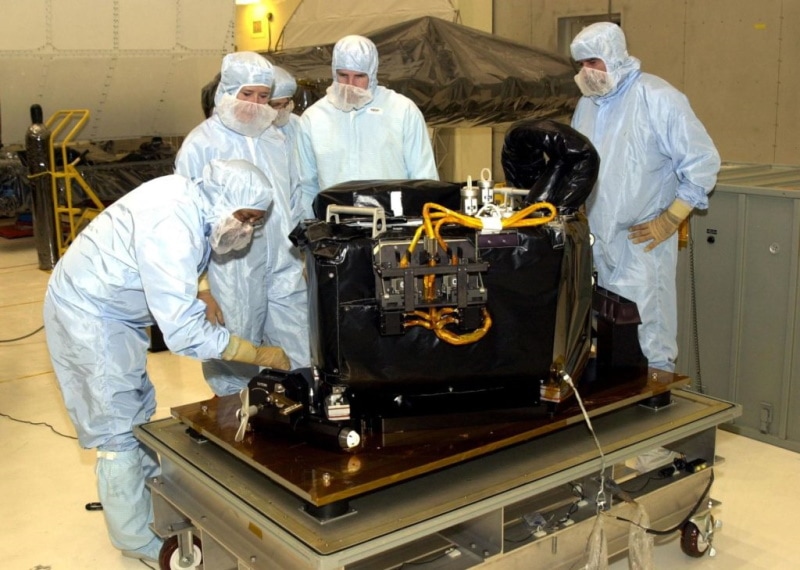What Is Infrared Light? Definition & Top Uses
Last Updated on

Infrared is a type of energy on the electromagnetic spectrum. Invisible to the human eye, infrared energy is given off by all heat sources. Discovered in 1800 by William Herschel, infrared can be detected using instruments like night-vision goggles and infrared cameras.
As well as being used to detect heat sources even in dark environments, infrared is used for heating, cooking food, and short-range communications. TV remotes, for example, use infrared to communicate with an infrared receiver in the television set.
Infrared is also used by astronomers that can “see” the infrared waves emitted by cooler objects like planets and nebulae. Prolonged exposure to infrared can cause damage to parts of the eye as well as to the skin.

How Does It Work?
Infrared was discovered in 1800 by astronomer William Herschel. Herschel set up a glass prism to detect the different temperatures of colored light. As light passes through a prism, it is separated as a light spectrum. Herschel measured the temperature of each color of light, discovering that temperature increased through the spectrum of light with red producing the highest temperature.
On this discovery, he decided to measure the temperature of light outside the visible spectrum. Not only did he determine that light just beyond red was hotter than visible light but that it reflected, refracted, and transmitted in the same way as visible light. Herschel’s experiment heralded the first discovery of light beyond the visual spectrum of light and marked the discovery of infrared.
All natural objects, that we know of, emit some level of thermal energy, which means that they emit infrared radiation. And different objects emit different levels of infrared, which means that using the right instruments, it is possible to differentiate between objects with different levels of thermal radiation. This is how infrared cameras and night-vision goggles work.
Objects emitting different levels of infrared light display different colors. And, because the density of the object also affects the level of infrared, it means that infrared can be used to give a good representation of otherwise invisible or difficult-to-see objects.
Infrared waves are longer than those of visible light. This also enables them to pass through dust and gas with less disruption than visible light. Therefore, it can be used to obtain a clearer picture of objects that would be otherwise blocked from our sight.
Infrared instruments, like night-vision goggles, use sensors that detect and measure the level of infrared radiation given off by objects. They then display the radiation on a screen or monitor, showing different levels of infrared with different colors, producing an image that is similar to how we would see the objects under normal lighting conditions. Infrared radiation would otherwise be invisible to the human eye.
What Are the Different Types of Infrared?

Infrared has waves between 0.78 and 1000 microns and temperatures from just above absolute zero to several thousand degrees. Because of this wide range of properties, infrared radiation is broken down into three separate types, according to the temperature of the light.
Near Infrared: Also known as shortwave infrared, near-infrared has a wavelength between 0.78 and 1.5 microns and covers temperatures from several hundred to several thousand degrees.
Medium Infrared: Also known as middle infrared, medium infrared has a wavelength from 1.5 to 3 microns and temperatures from several hundred up to nearly 1,000 degrees.
Far Infrared: Also known as longwave infrared, far infrared has wavelengths between 3 and 1000 microns and typically has a temperature between several hundred degrees right down to absolute zero.
The shorter the length of the IR wave, the hotter the temperature and the further it can travel. This makes it useful for heating, although too short a wavelength means that temperatures can be too high for practical heating use.
The Draper Point, which occurs at around 525 degrees, is usually considered the sweet spot for human use. This is the point on the border between medium and far infrared and represents an ideal mix of transmissibility and absorption.

Where Is It Used?

The most common use of infrared is in TV and other remote controls, but invisible light has surprising uses in other areas, too.
- Short-Range Communications: Infrared remotes use infrared for short-range communications. The remote sends out a pulse of signals which are received and decoded by a receiver in the device being controlled. Other short-range communication applications include fiber optic cables that can be used to transmit data. These are used in modern Internet cables to facilitate the sending and receiving of large amounts of data in a very short space of time.
- Astronomy: Herschel himself was an astronomer, so it is fitting that infrared is widely used in astronomy. Infrared light is capable of penetrating, or “seeing”, through gas and dust, which are present in space. They can block visible light and prevent us from being able to see planets, stars, and other objects. Because infrared can also differentiate between objects with different temperatures, it can be used to give a clear picture of objects and groups of objects in space.
- Heating: Infrared can provide instant heat and IR heaters are virtually silent. However, they are energy intensive because they use electricity to generate the required power, and the heater itself can get very hot at the source.
- Therapeutic Uses: Infrared light can help cells of the body regenerate and improve blood flow, which means that IR light has a lot of therapeutic uses and applications. It can be used for pain relief, to improve circulation, and to boost the immune system. It is also used in detoxification and skin cleansing.
Advantages of Infrared
The advantages and disadvantages of infrared depend on its application.
- Infrared enables us to “see” otherwise obscured objects. This includes seeing objects at night and being able to see distant objects through gas and dust.
- Infrared communication is deceptively simple. It is effectively just a series of light pulses that can be coded at the source and decoded on receipt.
- Infrared communication is secure. The transmitter needs to be pointed directly at the receiver, which makes it difficult, although not impossible, to intercept the communication.
- Infrared emits heat instantly, which is especially useful in heating and food cooking applications. There is no warm-up time.
Disadvantages of Infrared
- Line of sight is required for infrared communication. For example, if the dog gets in the way of your TV remote, it won’t work, and this is true of all forms of IR communication.
- IR light can cause damage to the eyes and skin, through prolonged exposure, which limits its use as a heat source or in therapeutic applications.
Frequently Asked Questions (FAQs)

Is infrared light good for your skin?
Infrared light is both helpful and harmful to the skin. It can help heal injuries and may reduce blemishes. It also improves blood circulation which positively affects the skin. However, prolonged exposure, or exposure to intense infrared, can burn and may cause long-term damage to the skin. Those that are exposed to IR long-term should use protection.
Do all objects emit infrared?
All objects above absolute zero emit infrared. There are no known objects with a temperature as low as absolute zero, either man-made or created in a lab, because it would theoretically take infinite energy to create something at this temperature. In all practical terms, every single object emits some infrared.
What does infrared do to the human brain?
Prolonged exposure to infrared can damage the brain, causing long-term damage. However, infrared can also be used to stimulate brain cells which enables the brain to carry out its normal activities.

Conclusion
Infrared is a form of light that is just beyond the red end of the visible light spectrum. It is invisible to the human eye but is emitted by all objects. Using sensors and receivers, it is possible to view the infrared emitted by different objects, making it useful for night vision and in fields such as astronomy. It can also be used for applications such as heating and has therapeutic uses especially for the skin and in cell recovery.
Featured Image Credit By: Quality Stock Arts, Shutterstock
About the Author Robert Sparks
Robert’s obsession with all things optical started early in life, when his optician father would bring home prototypes for Robert to play with. Nowadays, Robert is dedicated to helping others find the right optics for their needs. His hobbies include astronomy, astrophysics, and model building. Originally from Newark, NJ, he resides in Santa Fe, New Mexico, where the nighttime skies are filled with glittering stars.
Related Articles:
Binocular Magnification Chart: Numbers & Distances Compared
What Is the Best Binocular Magnification for Hunting? Optical Features Explained
When Were Binoculars Invented? History, Today & Future
How to Clean a Refractor Telescope: Step-by-Step Guide
How to Clean a Telescope Eyepiece: Step-by-Step Guide
How to Clean a Rifle Scope: 8 Expert Tips
Monocular vs Telescope: Differences Explained (With Pictures)
What Is a Monocular Used For? 8 Common Functions
